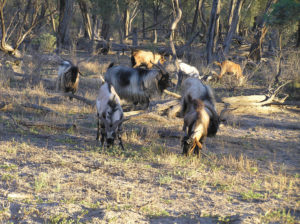Feral goat control
Feral Goats can cause a significant impact on agricultural production and the environment. They cause an estimated loss of $25 million per year to livestock farming. This does not include their impact on the environment or pasture degradation. Feral goats can consume or damage pasture and native habitats. The main methods of feral goat control include trapping, shooting, mustering and fencing. Shooting is a pest control method that can be undertaken by a wide range of people. This includes government vertebrate pest control officers, landholders and licensed shooters. Shooting is humane and very target specific and can be used to control feral goats. It can work in collaboration with other pest control techniques to reduce the impacts and populations of feral goats across larger areas. Shooting can be conducted both during the day and night. Various techniques of shooting such as sit/wait positioning near water sources during dry periods and drawing on Judas goats (radio collared) can be employed to increase the efficiency of feral goat control activities. Shooting can be an expensive option if landholders need to employ a full-time, part-time or contract professional shooter/s. If shooting is conducted at no-cost by accredited volunteer shooters it then becomes one of the cheapest pest control techniques available. Landholders can then use costs saved by utilising volunteer shooters to fund other complementary pest management tools.Act Now!
The SSAA Farmer Assist program enables landholders to find licensed, accredited and insured volunteer shooters to assist with feral goat control. We have thousands of qualified members across the country ready to assist you with feral goat control. The SSAA Farmer Assist program only takes a few minutes to register for so you can find friendly and willing volunteers to assist you with your feral goat problem.
